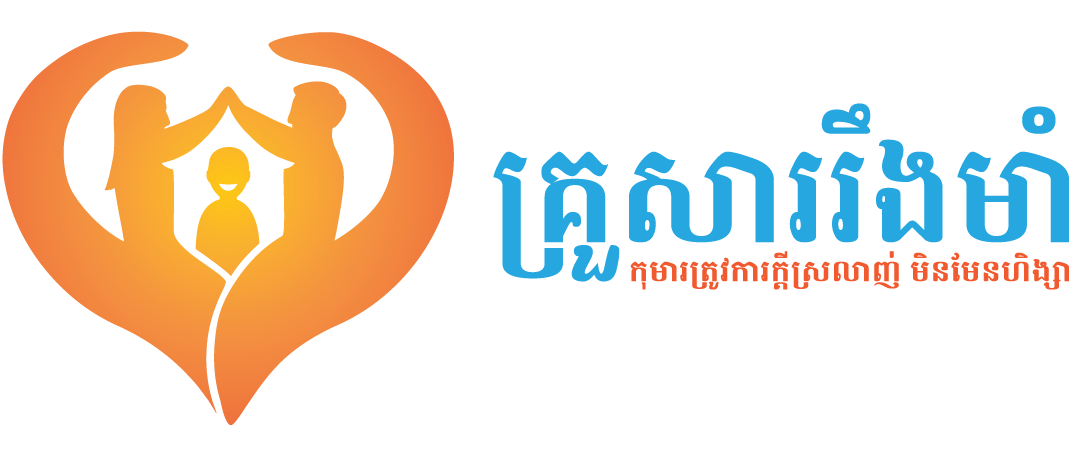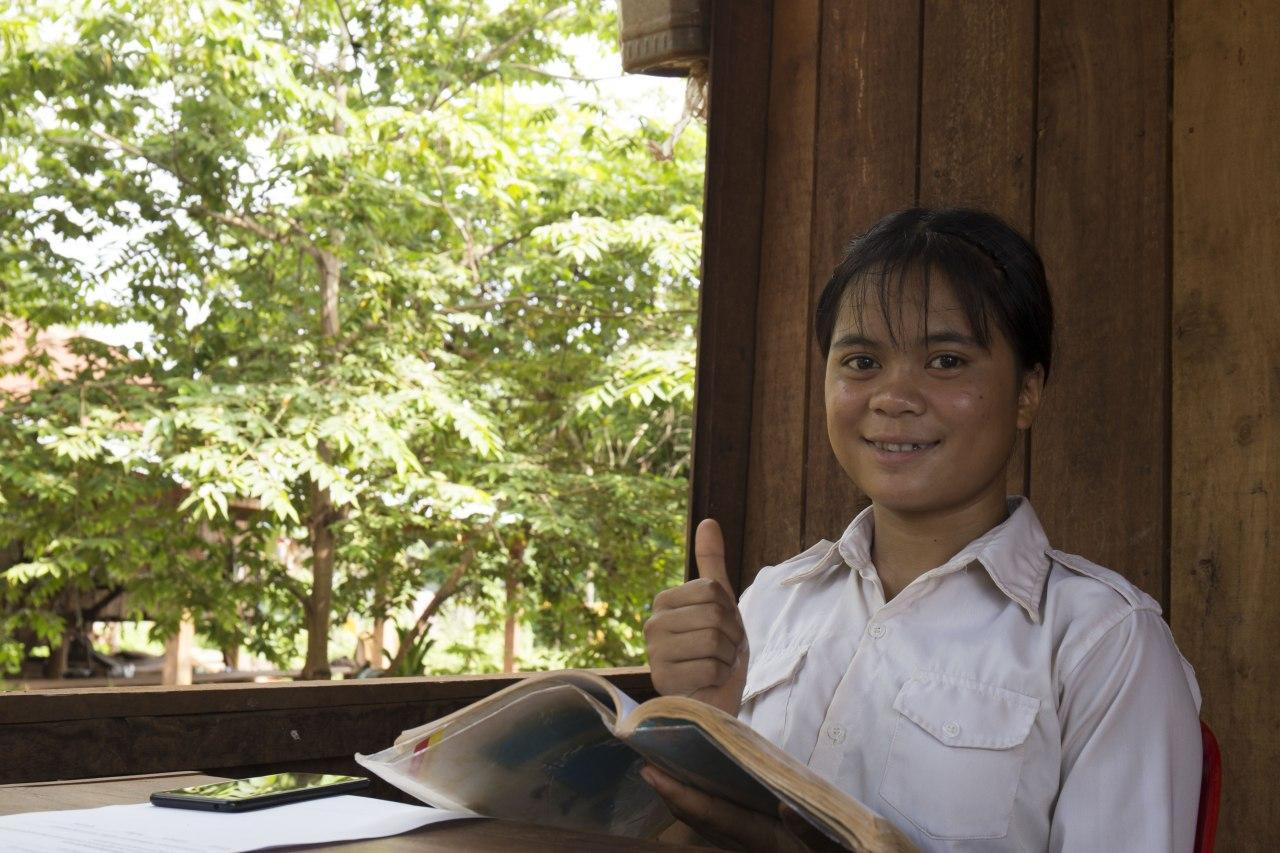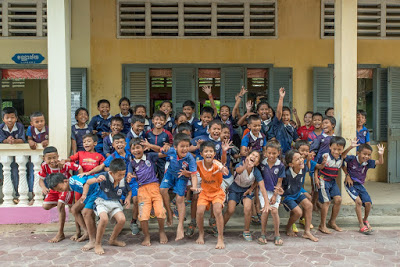
©UNICEF Cambodia/2020/Sea Sokhon
Ratanakiri, Cambodia, 25 June 2020 – Around 8.30am, the morning clouds diffuse the daylight and the small indigenous village of Romyol, in O’chum commune, O’chum district is quiet. There are some children gathering for their distance learning during COVID-19, but most of the adults are already out at work.
Sreyda, 16, is the oldest daughter of four children in a Kreung ethnic family. Her mother and stepfather work at a rubber tree farm. Sreyda is in Grade 7 at O’chum Lower Secondary School. Although the school has been closed for several months, she still accesses to her class through self-paced distance learning and an online programme. Sreyda is very good at Khmer literature and she is always the top student in the class.
Social norms put pressure on girls from ethnic communities to marry at a very young age, and consider girls over 18 years as an older woman or “expired girl”. But Sreyda dreams of being a teacher in future. “In the future, I want to be a good teacher and I would like to help many indigenous children, especially my Kreung ethnic community.” she said.
Sreyda recalls discovering her passion and her role model. One day while waiting her football class to start, Sreyda saw a video clip posted on Facebook. When she scrolled down to view the video she was surprised to find that one of her classmates was a performer in an educational video. The video was about domestic violence happening among young couple. Sreyda was impressed by her friend’s action. “I want to be like my friend and help other indigenous teenagers,” she said.
Her friend is one of the members of the Adolescent and Youth Reference Group in Ratanakiri province. The group was established by the local NGO, Save Vulnerable Cambodians (SVC), with support from UNICEF Cambodia. SVC has provided awareness raising sessions and training to members of the reference group, aiming to strengthen the capacity of adolescents and youth in communities and engage them to take action to prevent child marriage. Five education videos and two posters on preventing child marriage were produced with by the Adolescent and Youth Reference Group and distributed to communities offline and online.
Since seeing the video, Sreyda and her friend have become closer to each other. They often talk about different topics that concern young people, especially issues that most ethnic teenagers are facing in their community.
Sreyda participates in community engagement activities organized by the commune committee for women and children with support from SVC and UNICEF Cambodia. She has joined discussions with elderly women in the community and listened to their problems. She learned that they are facing huge health issues due to the consequences of getting married at a young age.
Sreyda saw her friend as an example. Her friend shared the experiences of being a young wife. “One of my friends had to quit education and was engaged at a young age. She had children at age 14. Now she has been going through many complicated problems including domestic violence and personal health matters.”

Sreyda’s biological father tragically died in a car crash. Losing her father was like losing part of her life and her family went through a hard time. Later, her mother married another man.
When Sreyda was 15 years old, her mother, Kanhoy Nourn, and her aunt wanted her to drop out of school and marry her cousin, who is just three years older. But Sreyda refused and the arrangement was cancelled, causing the relationship between her mother and her aunt to break down.
Her mother insisted that Sreyda marry at a young age, whenever men came and offered marriage proposals. But Sreyda always rejected these requests. She claimed that she was very young and that she wanted to continue her studies. Sreyda used different approaches to convince her mother. She used the lessons and skills that she learned from her friends, as well as the educational video to explain to her mother the negative consequences of early marriage.
The commune committee for women and children and older women in the community helped Sreyda explain to her mother the benefits of education for girls, and Kanhoy Nourn gradually changed her mind and stopped insisting that Sreyda get married.
Initially it was hard for Sreyda’s mother to accept this, as her Kreung ethnic community has been influenced by the culture and social norms of teenage marriage. Kanhoy Nourn admitted that she used to tell her daughter to get married.
“When I saw my daughter grow up and start to go out every day with her friends, I thought that was not good for a girl,” Nourn said. “That’s why I wanted her to get married as soon as possible.”
Once the mother and daughter understood each other, their relationship started to improve. Nourn knows that her daughter wants to be a teacher in future and she understands the importance of education, having joined a village meeting on child marriage prevention conducted by the commune council and the village chief. Now she not only lets her daughter study at school, she also fully supports her in pursuing her dream.

Local authorities have played a critical role in suppressing child marriage and decreasing the rates of marriage of girls under 15 years of age. Mrs. Khahn Sovy, the chief of the O’chum commune explained that awareness raising had been crucial.
“We raised awareness among people within our commune in order to understand the different risks of child marriage,” she said. “This included separating children from their families, taking children out of school, denying them interaction with their peers and participation in community activities.”

©UNICEF Cambodia/2020/Sea Sokhon
The Provincial Action Plan to Prevent Child Marriage and Teenage Pregnancy in Ratanakiri was endorsed by the Provincial Governor in 2018. With the generous support of UNICEF Australia, UNICEF Cambodia supports the provincial women and children consultative committee in Ratanakiri, the Ministry of Women’s Affairs and NGO partners to develop and implement this Action Plan. Some 34,451 people (20,678 women) have been reached with awareness raising sessions on preventing child marriage.












